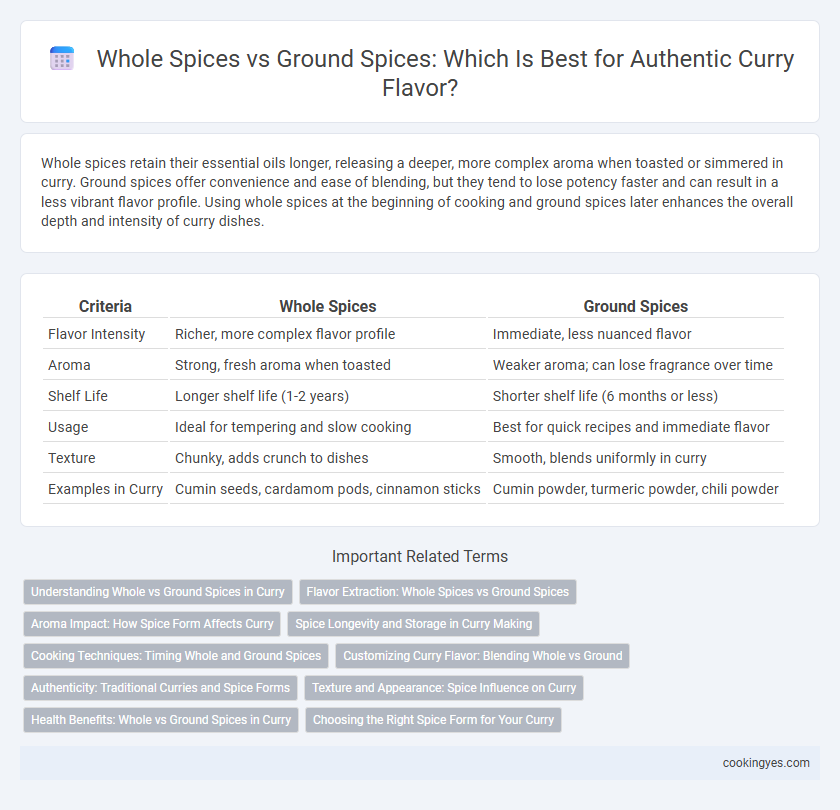Whole spices retain their essential oils longer, releasing a deeper, more complex aroma when toasted or simmered in curry. Ground spices offer convenience and ease of blending, but they tend to lose potency faster and can result in a less vibrant flavor profile. Using whole spices at the beginning of cooking and ground spices later enhances the overall depth and intensity of curry dishes.
Table of Comparison
| Criteria | Whole Spices | Ground Spices |
|---|---|---|
| Flavor Intensity | Richer, more complex flavor profile | Immediate, less nuanced flavor |
| Aroma | Strong, fresh aroma when toasted | Weaker aroma; can lose fragrance over time |
| Shelf Life | Longer shelf life (1-2 years) | Shorter shelf life (6 months or less) |
| Usage | Ideal for tempering and slow cooking | Best for quick recipes and immediate flavor |
| Texture | Chunky, adds crunch to dishes | Smooth, blends uniformly in curry |
| Examples in Curry | Cumin seeds, cardamom pods, cinnamon sticks | Cumin powder, turmeric powder, chili powder |
Understanding Whole vs Ground Spices in Curry
Whole spices retain their essential oils and vibrant flavors longer than ground spices, making them ideal for infusing deep, complex aromas into curries during cooking. Ground spices release their flavors quickly but tend to lose potency faster, so they are best added at the end of cooking to enhance the dish's immediate taste. Understanding the balance between whole and ground spices allows for precise control over curry flavor intensity and texture, resulting in a more authentic and layered culinary experience.
Flavor Extraction: Whole Spices vs Ground Spices
Whole spices release their essential oils gradually when toasted or simmered, providing a deeper, more complex flavor profile for curries. Ground spices offer immediate flavor extraction but tend to lose potency faster due to increased surface area exposure to air. Using whole spices initially and ground spices later in the cooking process maximizes flavor extraction and balance.
Aroma Impact: How Spice Form Affects Curry
Whole spices retain essential oils longer, releasing intense, layered aromas when toasted or tempered in hot oil, enhancing the depth of curry flavors. Ground spices offer immediate and evenly distributed aroma but tend to lose their volatile oils quickly, resulting in a less complex scent profile over time. Using whole spices at the start of cooking and ground spices toward the end optimizes the curry's aromatic impact and flavor complexity.
Spice Longevity and Storage in Curry Making
Whole spices retain their essential oils and aromatic compounds longer than ground spices, ensuring a fresher and more robust curry flavor over time. Properly stored whole spices in airtight containers away from light and heat can maintain potency for up to two years, whereas ground spices typically lose their intensity within six months. Using whole spices and grinding them just before cooking enhances spice longevity and maximizes flavor complexity in curries.
Cooking Techniques: Timing Whole and Ground Spices
Whole spices release essential oils slowly, making them ideal for tempering at the beginning of cooking to infuse curry with deep, layered flavor. Ground spices deliver immediate intensity and are best added later in the cooking process to preserve their aroma and prevent bitterness. Balancing the timing of whole and ground spices enhances the curry's complexity and ensures a well-rounded, fragrant dish.
Customizing Curry Flavor: Blending Whole vs Ground
Customizing curry flavor relies on balancing whole and ground spices, where whole spices like cumin, cardamom, and cloves release vibrant aromas when toasted, enhancing depth and complexity. Ground spices provide immediate intensity and uniformity, allowing precise control over heat and taste. Combining both forms enables layering of flavors, achieving a rich, nuanced curry profile tailored to personal preference.
Authenticity: Traditional Curries and Spice Forms
Whole spices, such as cumin seeds, coriander pods, and cloves, are essential for authentic traditional curries because they release deep, complex aromas when toasted or tempered in oil. Ground spices, while convenient, often lack the vibrant freshness and layered intensity achieved by whole spices freshly ground during cooking. Maintaining whole spices in recipes preserves the genuine essence and robust flavor profiles characteristic of regional curry traditions.
Texture and Appearance: Spice Influence on Curry
Whole spices in curry provide a robust texture and visual appeal, releasing essential oils slowly to enhance flavor complexity and create bursts of aroma throughout the dish. Ground spices, on the other hand, integrate smoothly, offering a uniform texture and consistent coloration that intensifies the curry's overall depth. Choosing whole or ground spices significantly influences the curry's sensory experience, balancing texture and appearance to suit specific culinary preferences.
Health Benefits: Whole vs Ground Spices in Curry
Whole spices in curry retain essential oils and volatile compounds longer than ground spices, preserving higher antioxidant levels and enhancing anti-inflammatory properties. Ground spices offer convenience but may lose potency and health benefits faster due to increased surface area exposure to air and light. Using whole spices in curry not only maximizes flavor but also delivers greater concentrations of bioactive compounds that support immune health and digestion.
Choosing the Right Spice Form for Your Curry
Whole spices retain essential oils longer, offering a fresher and more robust flavor for curry dishes when toasted or fried in oil before cooking. Ground spices provide convenience and quick infusion but can lose potency faster and may require careful timing to avoid bitterness. Selecting whole spices ensures depth and complexity, while ground forms are ideal for rapid preparation and consistent seasoning.
Whole spices vs Ground spices for curry flavor Infographic

 cookingyes.com
cookingyes.com